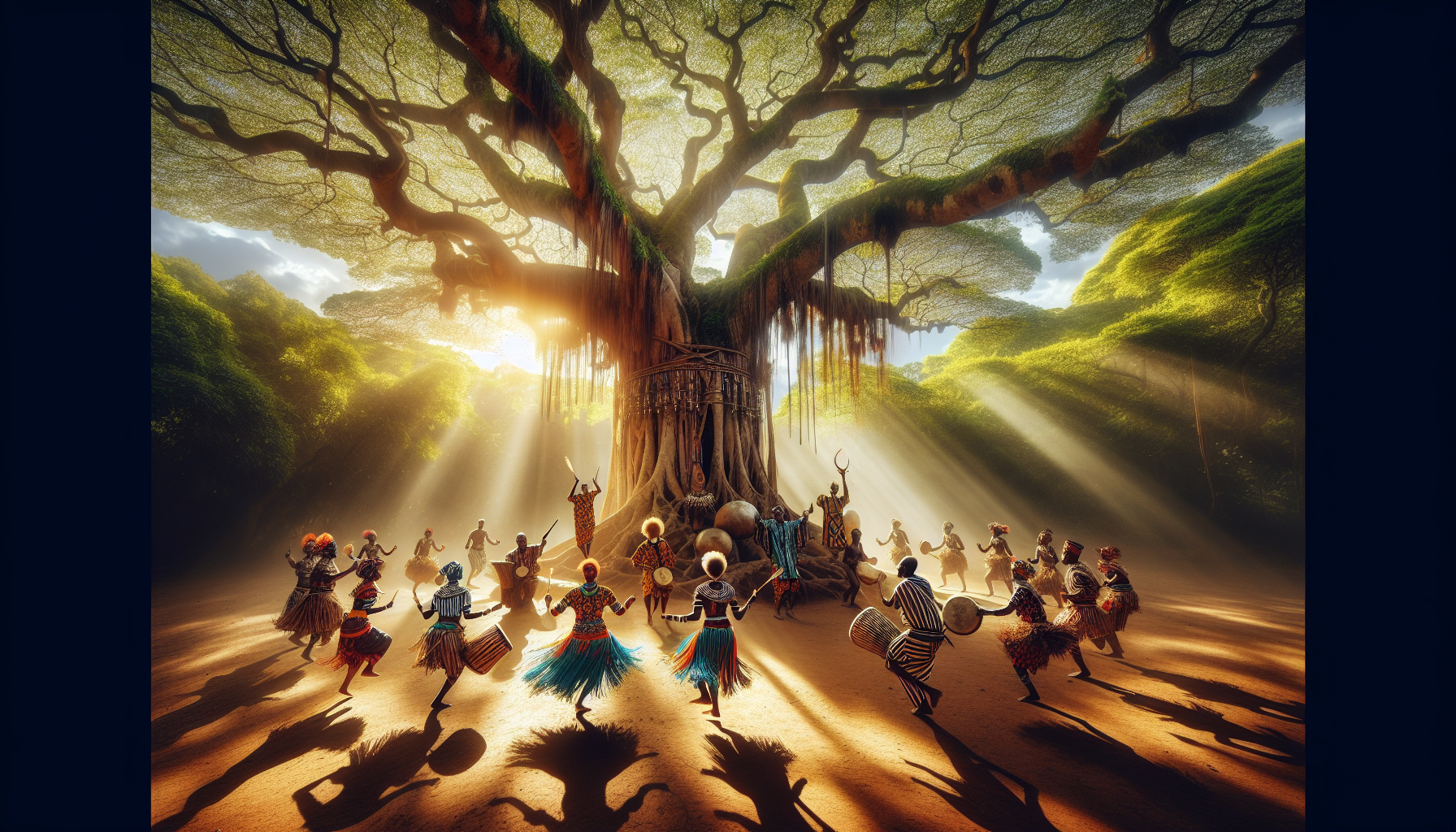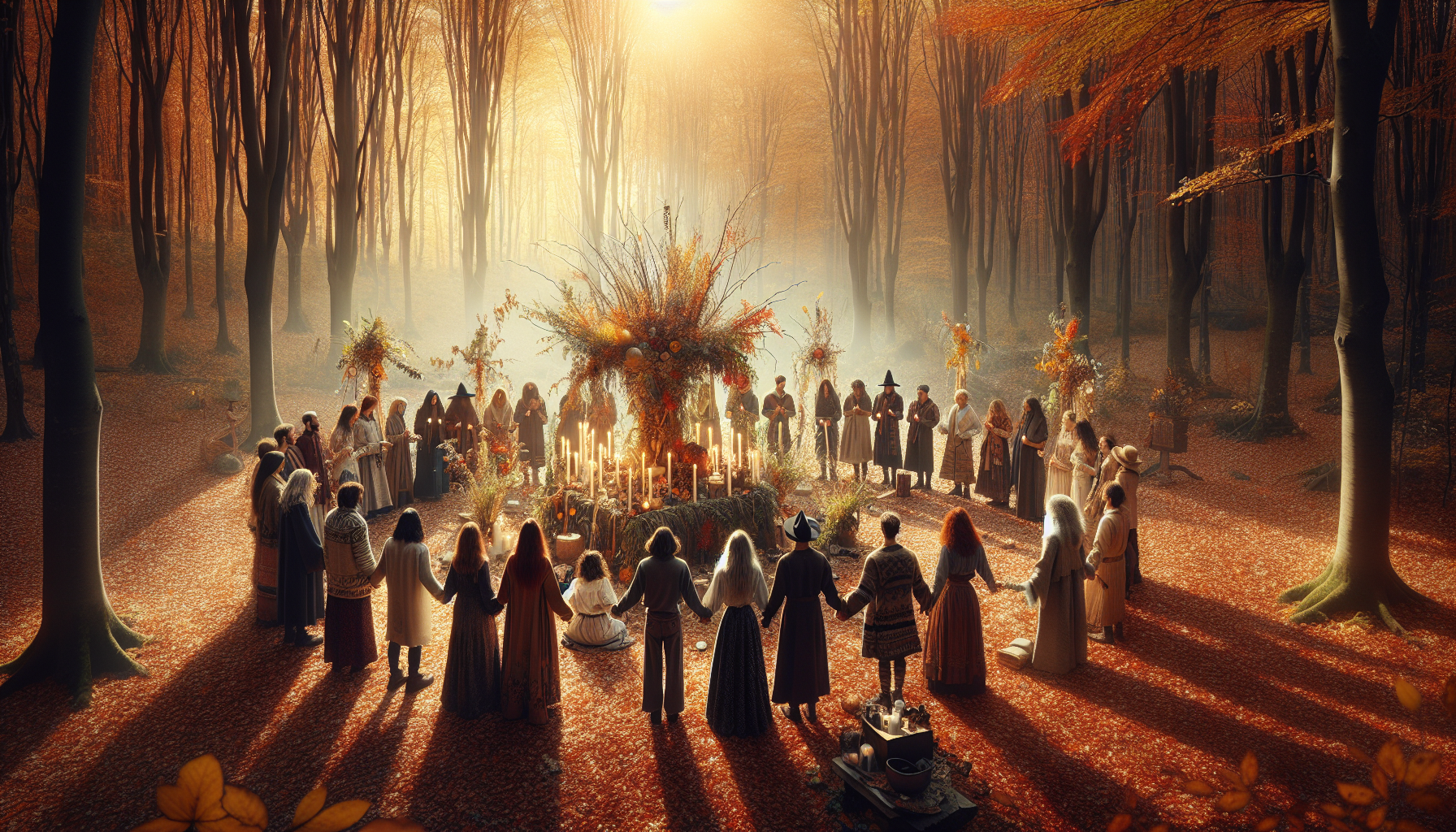In the heart of Africa, where the earth’s vibrant rhythms pulse through every living being, lies a tradition as ancient as the continent itself: the mesmerizing tree dancing rituals. These rituals, deeply rooted in the rich tapestry of African culture, serve as a testament to the enduring connection between humanity and nature. They are a celebration of life, a spiritual journey, and a communal gathering that transcends generations. The enchanting dances, filled with rhythmic movements and spiritual symbolism, invite participants and onlookers alike into a world where the physical and the metaphysical blend seamlessly. 🌿
Tree dancing rituals are not mere performances; they are profound expressions of cultural identity and heritage. Each movement tells a story, each rhythm resonates with the heartbeat of the community, and each dance serves as a conduit for spiritual communication. These rituals vary significantly across the continent, from the sacred Baobab ceremonies in West Africa to the vibrant Mopane dances in the South. Yet, despite their diversity, they all share a common thread: the deep reverence for trees as symbols of life, strength, and continuity. In these rituals, trees are not just part of the landscape; they are ancestors, guardians, and spiritual vessels.
The origins of tree dancing rituals are as varied as the tribes and communities that practice them. Some trace their roots back to ancient agricultural rites, where dances were performed to ensure bountiful harvests. Others find their beginnings in ancestral worship, where trees are seen as the embodiment of forebears who guide and protect the living. Still, others are believed to be gifts from the gods, imparted to humanity to maintain harmony between the earthly and the divine. Each dance is a unique tapestry woven from myths, legends, and the ever-evolving history of the people who cherish them.
As we delve deeper into the captivating world of tree dancing rituals, we will explore the distinct styles and interpretations found across Africa. From the intricate footwork and vibrant costumes of the Zulu tribes to the soulful melodies and meditative movements of the Yoruba people, each dance offers a glimpse into the cultural soul of its practitioners. We will also uncover the modern resurgence of these ancient practices, as contemporary African societies seek to preserve and revitalize their ancestral traditions in the face of globalization and cultural homogenization. 🌍
The Deep Cultural Significance of Tree Dancing Rituals
Tree dancing rituals in Africa are more than mere celebrations; they are intricate cultural expressions deeply rooted in history and spirituality. These rituals are performed by various ethnic groups across the continent and serve as a medium for connecting with ancestral spirits, nature, and the community. The significance of these rituals is multifaceted, involving spiritual, ecological, and social dimensions that provide insight into the African worldview.
In many African cultures, trees are considered sacred entities. They are often regarded as homes for spirits and ancestors, providing a vital link between the earthly and spiritual realms. This belief transforms the act of dancing around or with trees into a ceremonial homage to these spirits. The rituals vary widely among different cultures but commonly involve rhythmic movements, chants, and music that are believed to invoke the presence of spirits, offering blessings and guidance to the community. For instance, among the Yoruba of Nigeria, the Iroko tree is revered, and specific dances are performed to honor its significance.
The ecological aspect of these rituals cannot be overstated. They often highlight the community’s respect for the environment and its resources. By integrating trees into their spiritual practices, African communities emphasize the need for conservation and sustainable use of natural resources. This respect for nature is a crucial element of the rituals, reflecting a deep understanding of the interconnectedness between humans and the natural world.
Spiritual Dimensions of Tree Dancing
Tree dancing rituals are laden with spiritual symbolism. These dances are often seen as a form of communication with the divine, where the physical movements of the dancers serve as a language through which messages are conveyed to and from the spiritual realm. The rhythm of the dance, the songs, and the presence of the tree all create a sacred space that facilitates this divine interaction.
The spiritual dimension of these rituals is also evident in the preparation and execution of the dance. Participants often engage in fasting, prayer, and other forms of spiritual cleansing before the ritual. This preparation underscores the seriousness with which the rituals are taken and highlights their spiritual significance. The dance itself is a form of offering, a way to express gratitude, seek protection, and ask for prosperity from the spiritual entities believed to inhabit the trees.
Moreover, the role of the spiritual leader or shaman in these rituals is vital. They guide the ceremony, interpreting the spiritual messages received during the dance and ensuring that the community adheres to the traditional protocols. This leadership ensures the continuity of the cultural heritage and the proper transmission of spiritual knowledge across generations.
The Role of Music and Chants in Tree Dancing Rituals
Music and chants are integral components of tree dancing rituals, acting as the heartbeat that synchronizes the participants’ movements and spirits. The use of traditional instruments like drums, rattles, and flutes helps create a hypnotic rhythm that is believed to elevate the dancers’ consciousness, enabling a deeper connection with the spiritual realm. Each instrument carries its symbolism and purpose, contributing to the overall spiritual ambiance of the ritual.
Chants and songs, often passed down through generations, contain rich oral traditions that encapsulate the community’s history, values, and beliefs. These vocal expressions are not just artistic performances but are seen as a form of prayer and invocation. The lyrics often praise the spirits, recount historical events, or offer moral teachings, reinforcing the community’s cultural identity.
The interaction between music and dance in these rituals is profound. The rhythm dictates the dance’s pace and style, while the dance, in turn, influences the music’s intensity and flow. This symbiotic relationship creates a dynamic spiritual experience that engages all participants, fostering a sense of unity and communal identity. As you explore the nuances of these rituals, consider watching this enlightening video: The Spirit of African Drumming – Drums of Africa, YouTube Channel.
Comparative Analysis of Different Tree Dancing Rituals
The diversity of tree dancing rituals across Africa is vast, with each culture adding its unique flavor to the tradition. This diversity can be seen in the varying styles of dance, the types of trees involved, and the specific cultural meanings attached to each ritual. Below is a table that highlights some of these differences:
| Culture | Tree Used | Ritual Purpose | Musical Instruments |
|---|---|---|---|
| Yoruba | Iroko | Spiritual Protection | Drums, Shekere |
| Maasai | Acacia | Rainmaking | Flutes, Drums |
| Zulu | Marula | Fertility and Harvest | Mbira, Drums |
As you can see, each culture brings its distinct elements to the rituals, reflecting their unique relationship with the environment and their spiritual beliefs. These differences highlight the rich tapestry of African cultural practices and their adaptability to local ecological and social contexts.
Social and Communal Aspects of Tree Dancing Rituals
Tree dancing rituals are not only spiritual and ecological events but also significant social gatherings. They play a crucial role in strengthening community bonds and fostering social cohesion. These rituals often coincide with important communal events such as weddings, harvests, or rites of passage, serving as a platform for communal celebration and unity.
During these gatherings, social hierarchies and roles are often reinforced or challenged. The rituals provide an opportunity for community members to express their social identities and roles within the group. Elders may take the opportunity to impart wisdom and guidance, while younger members demonstrate their learning and understanding of cultural values through their participation.
The social aspect of tree dancing rituals is also evident in the collaborative nature of the performances. The community’s involvement in the preparation, execution, and aftermath of the ritual creates a sense of shared responsibility and collective identity. This collaboration extends beyond the ritual itself, as the bonds formed and strengthened during these events often translate into everyday social support and cooperation.
Impact on Modern Society and Global Perceptions
In contemporary times, tree dancing rituals continue to hold relevance, both within Africa and beyond. They offer a lens through which the global community can understand and appreciate the depth of African cultural traditions. As the world becomes more interconnected, there is a growing interest in preserving and promoting these rituals as part of the global cultural heritage.
Tree dancing rituals have also found their way into global artistic expressions, influencing music, dance, and theater. This cross-cultural exchange enriches the global arts scene and promotes a deeper understanding and appreciation of African cultural practices. However, there is a delicate balance between appreciation and appropriation, and it is crucial to engage with these cultural expressions respectfully and ethically.
In today’s world, where environmental concerns are increasingly pressing, tree dancing rituals offer valuable insights into sustainable living and the importance of maintaining a harmonious relationship with nature. These rituals remind us of the intrinsic value of nature and the need to protect it for future generations. As you reflect on these practices, consider how they might inform and inspire contemporary approaches to environmental conservation and cultural preservation.
- Explore the interconnectedness of spirituality and nature in African cultures.
- Appreciate the diversity and richness of African cultural practices.
- Reflect on the relevance of traditional rituals in modern society.

Conclusion
In conclusion, the article “Rooted in Tradition: Unveiling the Enchanting Tree Dancing Rituals of Africa” has taken us on a captivating journey through the diverse and vibrant cultural landscapes of Africa. Throughout this exploration, we have delved into the historical origins, cultural significance, and contemporary relevance of the tree dancing rituals that are a testament to the rich tapestry of African heritage.
Firstly, we revisited the historical context of these rituals, understanding how they have been passed down through generations as a means of preserving cultural identity and storytelling. These rituals are not merely dances but are deeply ingrained in the spiritual and social fabric of the communities, often symbolizing a connection to the ancestors, the earth, and the divine.
Moreover, we explored the intricate symbolism embedded within these dances. The movements, the music, and the costumes each tell a story, reflecting themes of fertility, harvest, healing, and community solidarity. These rituals often serve as a bridge between the past and the present, providing a space for reflection and celebration.
The article also highlighted the geographical diversity of these practices, noting variations across regions such as West Africa, East Africa, and Southern Africa. Each area brings its unique flavor and interpretation to the tree dancing rituals, yet they all share a common purpose: to honor their ancestors and foster a sense of community and belonging.
In contemporary times, these rituals have not lost their relevance. Instead, they have adapted to the changing social and political landscapes, serving as powerful tools for cultural expression and resistance. They are also gaining global recognition, as more people become interested in the richness of African traditions and the messages they convey.
Understanding and appreciating these rituals is crucial for fostering cross-cultural understanding and respect. As globalization continues to connect us, it becomes increasingly important to honor and preserve cultural diversity. These dances are not just performances; they are living expressions of identity, resilience, and continuity.
We encourage readers to engage with this rich cultural heritage actively. Consider attending local cultural events, participating in workshops, or even embarking on a journey to experience these rituals firsthand. Sharing knowledge and experiences can help sustain these traditions and promote greater awareness and appreciation.
Additionally, we invite you to share your thoughts and insights on this topic. How do these rituals resonate with you? Have you had any personal experiences with similar cultural practices? By contributing to the conversation, you help keep these traditions alive and thriving.
Feel free to explore more about African cultural practices through credible sources and academic articles. Websites such as the African Studies Center [https://www.africa.upenn.edu/] and UNESCO’s Intangible Cultural Heritage [https://ich.unesco.org/] offer valuable insights and resources.
In closing, let us celebrate the enchanting tree dancing rituals of Africa as a reminder of the beauty and complexity of human culture. May we continue to learn from and be inspired by these traditions, recognizing their vital role in shaping the world we live in today. 🌍✨
Gabriel is a visual storyteller and symbolic naturalist whose creations explore the veiled ecologies and ancestral ties between humans and the living world, as echoed through myth and memory. With a sensitivity attuned to the sacred, Gabriel unveils the ancient choreography of plant, animal, and spirit — a realm where forests spoke in signs, rivers kept secrets, and every flower bore a forgotten name.
His path winds through the esoteric — tracing the rituals of forest sages, the herbal codes of ancestral healers, and the silent agreements that once guided human life in deep reciprocity with nature. From moss-covered shrines to twilight groves, Gabriel’s work reveals relationships once vital, now buried beneath layers of modern detachment.
With a foundation in visual design and the aesthetics of ancestral wisdom, Gabriel weaves storytelling into sacred ecology. His work doesn’t just depict — it channels. Drawing from myth, mysticism, and lost herbal traditions, he crafts images and narratives that pulse with the old knowing: that nature is not scenery, but kin and teacher.
Through collections of symbolic visuals, myth-rooted studies, and intuitive reflections, Gabriel invites others to rekindle forgotten senses — to listen not only with ears, but with intuition, memory, and reverence.
His work is a tribute to:
-
The mythic language of trees, stones, and roots
-
Forgotten pacts between healers and the wild
-
The sacred intelligence in nature’s unseen patterns
Whether you walk with the lore of plants, dream with the rhythms of the earth, or simply feel the call of something older in the wind through the leaves, Gabriel welcomes you into a space where symbolism, spirit, and wild nature entwine — one myth, one leaf, one vision at a time.





